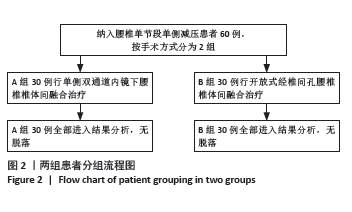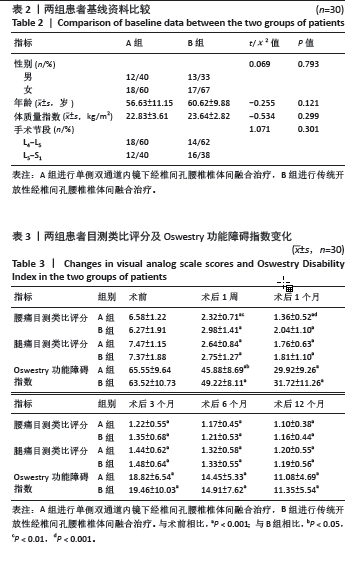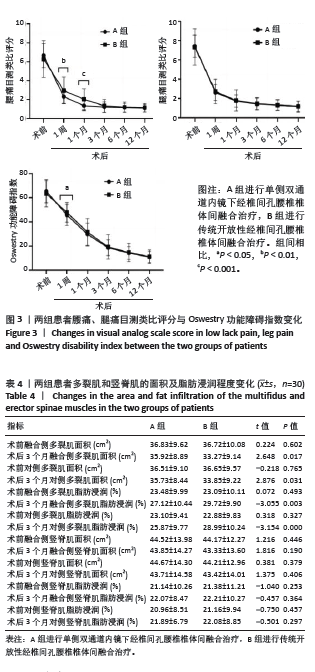[1] MOBBS RJ, PHAN K, MALHAM G, et al. Lumbar interbody fusion: techniques, indications and comparison of interbody fusion options including PLIF, TLIF, MI-TLIF, OLIF/ATP, LLIF and ALIF. J Spine Surg. 2015;1(1):2-18.
[2] KONG F, ZHOU Q, QIAO Y, et al. [Comparison of unilateral biportal endoscopic transforaminal lumbar interbody fusion versus minimally invasive tubular transforaminal lumbar interbody fusion for lumbar degenerative disease]. Zhongguo Xiu Fu Chong Jian Wai Ke Za Zhi. 2022;36(5):592-599.
[3] DING Q, TANG X, ZHANG R, et al. Do Radiographic Results of Transforaminal Lumbar Interbody Fusion Vary with Cage Position in Patients with Degenerative Lumbar Diseases? Orthop Surg. 2022; 14(4):730-741.
[4] KANG MS, HEO DH, KIM HB, et al. Biportal Endoscopic Technique for Transforaminal Lumbar Interbody Fusion: Review of Current Research. Int J Spine Surg. 2021;15(suppl 3):S84-S92.
[5] KIM JE, YOO HS, CHOI DJ, et al. Comparison of Minimal Invasive Versus Biportal Endoscopic Transforaminal Lumbar Interbody Fusion for Single-level Lumbar Disease. Clin Spine Surg. 2021;34(2):E64-E71.
[6] SONG KS, LEE CW, MOON JG. Biportal Endoscopic Spinal Surgery for Bilateral Lumbar Foraminal Decompression by Switching Surgeon’s Position and Primary 2 Portals: A Report of 2 Cases With Technical Note. Neurospine. 2019;16(1):138-147.
[7] HEO DH, SON SK, EUM JH, et al. Fully endoscopic lumbar interbody fusion using a percutaneous unilateral biportal endoscopic technique: technical note and preliminary clinical results. Neurosurg Focus. 2017;43(2):E8.
[8] GUO W, YE J, LI T, et al. Evaluation of the learning curve and complications in unilateral biportal endoscopic transforaminal lumbar interbody fusion: cumulative sum analysis and risk-adjusted cumulative sum analysis. J Orthop Surg Res. 2024;19(1):194.
[9] TIAN D, LIU J, ZHU B, et al. Unilateral biportal endoscopic extreme transforaminal lumbar interbody fusion with large cage combined with endoscopic unilateral pedicle screw fixation for lumbar degenerative diseases: a technical note and preliminary effects. Acta Neurochir (Wien). 2023;165(1):117-123.
[10] HEO DH, KIM JS, PARK CW, et al. Contralateral Sublaminar Endoscopic Approach for Removal of Lumbar Juxtafacet Cysts Using Percutaneous Biportal Endoscopic Surgery: Technical Report and Preliminary Results. World Neurosurg. 2019;122:474-479.
[11] PARK JH, JUN SG, JUNG JT, et al. Posterior Percutaneous Endoscopic Cervical Foraminotomy and Diskectomy With Unilateral Biportal Endoscopy. Orthopedics. 2017;40(5):e779-e783.
[12] HEO DH, EUM JH, JO JY, et al. Modified far lateral endoscopic transforaminal lumbar interbody fusion using a biportal endoscopic approach: technical report and preliminary results. Acta Neurochir (Wien). 2021;163(4):1205-1209.
[13] YOU X, ZHAO B, ZHANG T, et al. Clinical Efficacy of Unilateral Dual-channel Endoscopic Lumbar Interbody Fusion for Lumbar Spondylolisthesis with Spinal Scoliosis. Orthop Surg. 2024;16(5):1134-1142.
[14] FU H, HU Y, YANG D, et al. [Comparison of effectiveness between unilateral biportal endoscopic decompression and unilateral biportal endoscopic lumbar interbody fusion for degree Idegenerative lumbar spondylolisthesis]. Zhongguo Xiu Fu Chong Jian Wai Ke Za Zhi. 2024; 38(2):169-175.
[15] KIM JE, CHOI DJ. Biportal Endoscopic Transforaminal Lumbar Interbody Fusion with Arthroscopy. Clin Orthop Surg. 2018;10(2): 248-252.
[16] GATAM AR, GATAM L, MAHADHIPTA H, et al. Unilateral Biportal Endoscopic Lumbar Interbody Fusion: A Technical Note and an Outcome Comparison with the Conventional Minimally Invasive Fusion. Orthop Res Rev. 2021;13:229-239.
[17] SIHVONEN T, HERNO A, PALJARVI L, et al. Local denervation atrophy of paraspinal muscles in postoperative failed back syndrome. Spine (Phila Pa 1976). 1993;18(5):575-581.
[18] HAN G, JIANG Y, ZHANG B, et al. Imaging Evaluation of Fat Infiltration in Paraspinal Muscles on MRI: A Systematic Review with a Focus on Methodology. Orthop Surg. 2021;13(4):1141-1148.
[19] LIN GX, HUANG P, KOTHEERANURAK V, et al. A Systematic Review of Unilateral Biportal Endoscopic Spinal Surgery: Preliminary Clinical Results and Complications. World Neurosurg. 2019;125:425-432.
[20] KIM N, JUNG SB. Biportal endoscopic spine surgery in the treatment of multi-level spontaneous lumbar epidural hematoma: Case report. J Orthop Sci. 2022;27(1):288-291.
[21] HIRA K, NAGATA K, HASHIZUME H, et al. Relationship of sagittal spinal alignment with low back pain and physical performance in the general population. Sci Rep. 2021;11(1):20604.
[22] HIYAMA A, KATOH H, SAKAI D, et al. The correlation analysis between sagittal alignment and cross-sectional area of paraspinal muscle in patients with lumbar spinal stenosis and degenerative spondylolisthesis. BMC Musculoskelet Disord. 2019;20(1):352.
[23] MUELLNER M, HAFFER H, MOSER M, et al. Paraspinal musculature impairment is associated with spinopelvic and spinal malalignment in patients undergoing lumbar fusion surgery. Spine J. 2022;22(12): 2006-2016.
[24] LV Y, CHEN M, WANG SL, et al. Endo-TLIF versus MIS-TLIF in 1-segment lumbar spondylolisthesis: A prospective randomized pilot study. Clin Neurol Neurosurg. 2022;212:107082.
[25] LIN GX, YAO ZK, ZHANG X, et al. Evaluation of the Outcomes of Biportal Endoscopic Lumbar Interbody Fusion Compared with Conventional Fusion Operations: A Systematic Review and Meta-Analysis. World Neurosurg. 2022;160:55-66.
[26] CHOI DJ, CHOI CM, JUNG JT, et al. Learning Curve Associated with Complications in Biportal Endoscopic Spinal Surgery: Challenges and Strategies. Asian Spine J. 2016;10(4):624-629.
[27] KIM JE, YOO HS, CHOI DJ, et al. Learning Curve and Clinical Outcome of Biportal Endoscopic-Assisted Lumbar Interbody Fusion. Biomed Res Int. 2020;2020:8815432.
[28] KIM SK, KANG SS, HONG YH, et al. Clinical comparison of unilateral biportal endoscopic technique versus open microdiscectomy for single-level lumbar discectomy: a multicenter, retrospective analysis. J Orthop Surg Res. 2018;13(1):22.
[29] PANG D, YANG J, HAI Y, et al. Changes in paraspinal muscles and facet joints after percutaneous endoscopic transforaminal lumbar interbody fusion for the treatment of lumbar spinal stenosis: A 3-year follow-up. Front Surg. 2022;9:1041105.
[30] KAWAGUCHI Y, MATSUI H, TSUJI H. Back muscle injury after posterior lumbar spine surgery. Part 2: Histologic and histochemical analyses in humans. Spine (Phila Pa 1976). 1994;19(22):2598-2602.
|



